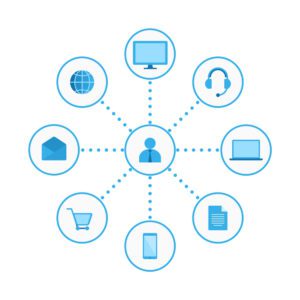In today’s marketplace, dealerships need to be customer centered, responsive, and agile to be successful. The internet opened up a new era that transformed the way buyers research vehicles before making their final decision.
Various studies over the years have shown that a large percentage of car buyers use their mobile phones to compare prices and models while they are physically present at the dealership or their lot.
According to Neilson Norman Group, users typically only read about 20% of the words present on a page. If your website does not have a clear call to action or message and it is cluttered, then users won’t be sticking around for long.
One indisputable fact is that the majority of leads will visit your website before they even think about visiting your dealership. Thus ensuring that your website needs to be functional and mobile responsive for them to search through your inventory, using any device of their choosing.
 It’s best to think of your website of an around the clock showroom where customers develop their first impressions of your brand and dealership. There’s now a move from the traditional four-walled dealership to a multi-channel store that makes the most of showrooms, informational e-kiosks, phones, and an active internet presence.
It’s best to think of your website of an around the clock showroom where customers develop their first impressions of your brand and dealership. There’s now a move from the traditional four-walled dealership to a multi-channel store that makes the most of showrooms, informational e-kiosks, phones, and an active internet presence.
Websites are key for a local car dealerships success within Google and online generally. Good dealership websites need to mirror the brand vision and in-shop experience for their customers (prospective and returning). Dealerships need to create a good design website that aligns with the brand and messaging of your dealership.
With technological advancements, dealerships should break away from software and templates that are solely for inventory management. They should avoid cluttered and busy website designs with the vehicle being the star of their websites.
Below are the five most important marketing efforts that an automotive dealership’s website should have present in order of importance.
-
The Landing Page
A website really only has two main purposes, which are to generate traffic and to convert that traffic into leads. Landing pages are critical to that process. Studies have shown that there is a higher rate of leads generated by sending users to landing pages rather than the home page.
Data collected from your landing pages can be tracked to help you gain a better understanding of how engaged your users are. Tracking data then allows you to have something to analyze as far as how your marketing offers are performing.
Landing pages help to inspire specific consumer action by removing distractions. They provide users with a singular display that promotes the action that you want the user to take.
An effective landing page has the following framework:
Above Fold Content
- Main Headline – should be an overview of the webpage.
- Supporting Headline – fills in important details.
- Hero Shot – as they say, a picture can say a thousand words.
- Benefit Summary – the hook that pulls people onto the rest of your content
Call To Action (CTA)
- Ensure that the CTA is simple and consistent throughout the webpage.
Show Them The Benefits
- Most users are asking whether this will make their lives easier. So the best option is for you to answer that question.
Social Proof
- Include a variety of testimonials
- Embed content
- Video testimonials
- Include pictures
- The more detail you have, the more believable it’ll be
- Cite high authority source
-
Add A Value Proposition
The value proposition, or better known as the mission statement, tell the user what you’re doing and why you’re doing it. Placing your value proposition on the home page (even better on the headline) will let your visitors know exactly what they’re getting into and convince them of buying vehicles from you, reading your blog, or even just subscribing to your newsletter.
As shown by the Content Marketing Institute, your missions statement should include:
[our dealership] is where
[our audience] gets
[what information] that offers
[what benefit]
-
Website Navigation and Mobile Friendliness
The navigation serves two main purposes, those being it helps your search engine rankings and helps users find what they are looking for. But your users should come first, followed by search engines. Try to use descriptive navigation rather than the generic ‘What We Do’ content. Try to utilize the words that you’re visitors and target market are searching for.
A mobile-friendly site used to be a ‘should/could have’ but it has now become a ‘must have’. With Google constantly updating their algorithm, it’s now more important than ever. Navigation and mobile friendliness play a big role in how high your website is ranked among other search engine results.
-
Website Color Palette
There are various places where the color palette is especially important, with the Call to Action being one of them. The CTA button should be an accent or contrasting color.
For example, if your site is mainly light blue or blue, try to find a warm orange or nice yellow that accents your existing color palette without being hidden. Using a complementary color can give your user a better idea on the spots that they can click on.
-
Testimonial and Team Pages
Not that many people actually click through to your testimonial page. Can you remember the last time you clicked on a websites testimonial page or saw that a site had one?
If you have clients that are saying great things about you, then that is amazing and should be shown. The best way to do so is actually by scattering it throughout your website, rather than dedicate an entirely separate page for all testimonial. If you’re using video testimonials, then try to find a way to tuck them onto your website or on actual product pages.
On the other hand, something that people want to see is your team. They want to know, trust, and like you before they even buy or contact you. So, letting your customers know the people who are behind the scenes at your dealership can help showcase your dealership’s culture. Individual team pages give a chance for you to rank in the search engine when people are searching for specific names.
References: Cars.com, Project320, Disruptive Advertising, Orbit Media Studios








